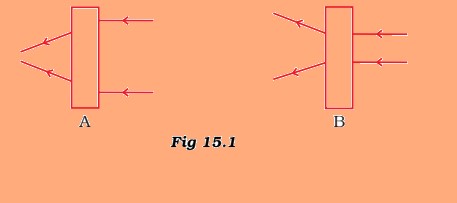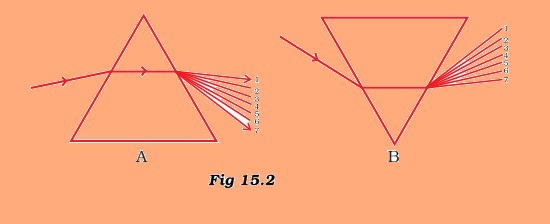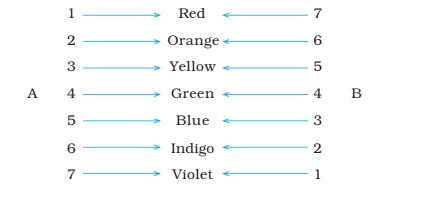Science
(www.olympiadsuccess.com)
Chapter 15: Light
Class: VII
Multiple Choice Questions
Question 1
Boojho and Paheli were given one mirror each by their teacher. Boojho found his image to be erect and of the same size whereas Paheli found her image erect and smaller in size. This means that the mirrors of Boojho and Paheli are, respectively
(a) plane mirror and concave mirror.
(b) concave mirror and convex mirror.
(c) plane mirror and convex mirror.
(d) convex mirror and plane mirror.
Answer 1
(c)
Question 2
Which of the following can be used to form a real image?
(a) Concave mirror only.
(b) Plane mirror only.
(c) Convex mirror only.
(d) Both concave and convex mirrors.
Answer 2
(a)
Question 3
If an object is placed at a distance of 0.5 m in front of a plane mirror, the distance between the object and the image formed by the mirror will be
(a) 2 m
(b) 1 m
(c) 0.5 m
(d) 0.25 m
Answer 3
(b)
Question 4
You are provided with a concave mirror, a convex mirror, a concave lens and a convex lens. To obtain an enlarged image of an object you can use either
(a) concave mirror or convex mirror.
(b) concave mirror or convex lens.
(c) concave mirror or concave lens.
(d) concave lens or convex lens.
Answer 4
(b)
Question 5
A rainbow can be seen in the sky
(a) when the sun is in front of you.
(b) when the sun is behind you.
(c) when the sun is overhead.
(d) only at the time of sun rise.
Answer 5
(b)
Question 6
An erect and enlarged image can be formed by
(a) only a convex mirror.
(b) only a concave mirror.
(c) only a plane mirror.
(d) both convex and concave mirrors.
Answer 6
(b)
Question 7
You are provided with a convex mirror, a concave mirror, a convex lens and a concave lens. You can get an inverted image from
(a) both concave lens and convex lens.
(b) both concave mirror and convex mirror.
(c) both concave mirror and convex lens.
(d) both convex mirror and concave lens.
Answer 7
(c)
Question 8
An image formed by a lens is erect. Such an image could be formed by a
(a) convex lens provided the image is smaller than object.
(b) concave lens provided the image is smaller than object.
(c) concave lens provided the image is larger than object.
(d) concave lens provided the image is of the same size.
Answer 8
(b)
Very Short Answer Questions
Question 9
The image formed by a lens is always virtual, erect and smaller in size for an object kept at different positions in front of it. Identify the nature of the lens.
Answer 9
Concave lens.
Question 10
Fill in the blanks:
(a) The inner surface of a steel spoon acts as a ___________ mirror.
(b) The outer surface of a flat steel plate acts as a ___________ mirror.
(c) The outer shining surface of a round bottom steel bowl acts as a __________ mirror.
(d) The inner surface of the reflector of a torch acts as a __________ mirror.
Answer 10
(a) concave
(b) plane
(c) convex
(d) concave
Question 11
State whether the following statements are True or False.
(a) A concave lens can be used to produce an enlarged and erect image.
(b) A convex lens always produces a real image.
(c) The sides of an object and its image formed by a concave mirror are always interchanged.
(d) An object can be seen only if it emits light.
Answer 11
(a) False
(b) False
(c) True
(d) False
Short Answer Questions
Question 12
What type of mirror is used as a side mirror in a scooter? Why is this type of mirror chosen?
Answer 12
Convex mirror. Convex mirrors can form images of objects spread over a large area. So these help the drivers to see the traffic of a large area behind them.
Question 13
Observe the figures given as Figure 15.1 carefully.

The given figures show the path of light through lenses of two different types, represented by rectangular boxes A and B. What is the nature of lenses A and B?
Answer 13
A – convex lens; B – concave lens.
Question 14
Boojho made light from a laser torch to fall on a prism. Will he be able to observe a band of seven colours? Explain with a reason.
Answer 14
No, laser torch gives out light of only one colour.
Question 15
State the correct sequence (1-7) of colours in the spectrum formed by the prisms A and B, shown in Figure 15.2.

Answer 15

Question 16
The side mirror of a scooter got broken. The mechanic replaced it with a plane mirror. Mention any inconvenience that the driver of the scooter will face while using it?
Answer 16
The driver will not be able to see traffic spread over a large area behind him.
Question 17
The concave reflecting surface of a torch got rusted. What effect would this have on the beam of light from the torch?
Answer 17
The beam of light will be diffused with lower intensity.
Question 18
An erect and enlarged image of an object is formed on a screen. Explain how this could be possible.
Answer 18
The image formed on the screen could be enlarged and erect if the object is placed upside down between F and 2F of the lens.
Question 19
Two different type of lenses are placed on a sheet of newspaper. How will you identify them without touching?
Answer 19
If the letters appear bigger/magnified, then the lens is a convex lens. If the letters appear smaller, then the lens will be concave lens.
Question 20
A shopkeeper wanted to fix a mirror which will give a maximum view of his shop. What type of mirror should he use? Give reason.
Answer 20
He will fix a convex mirror because it can form images of object spread over a large area.
Question 21
The distance between an object and a convex lens is changing. It is noticed that the size of the image formed on a screen is decreasing. Is the object moving in a direction towards the lens or away from it?
Answer 21
The object is moving away from the lens.
Long Answer Questions
Question 22
Suppose we wish to obtain the real image of a distant tree. Explain two possible ways in which we can do it.
Answer 22
Hint : (i) By using a concave mirror and a screen.
(ii) By using a convex lens and a screen.
Question 23
It was observed that when the distance between an object and a lens decreases, the size of the image increases. What is the nature of this lens? If you keep on decreasing the distance between the object and the lens, will you still able to obtain the image on the screen? Explain.
Answer 23
It is a convex lens. No, when the object is placed close to a convex lens then the
image formed is virtual which cannot be obtained on screen.
Question 24
You are given three mirrors of different types. How will you identify each one of them?
Answer 24
Hint : By forming images with the help of the three mirrors.
Yearlong program for Olympiads preparation & to build necessary skills for future.
Explore More
Time to mark your calendar with the upcoming Olympiads exam schedule.
Explore More
Take your Olympiad preparation to next-level by taking LIVE Classes.
Explore More
Assess your performance by taking topic-wise and full length mock tests.
Explore More
Online tuitions for international compeitions like SASMO, SEAMO, etc for Grades 1-11.
Explore More